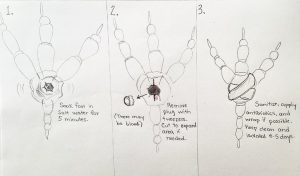Bumblefoot is one of the most common ailments in poultry. If you have chickens for any length of time, you are sure to run across it. Bumblefoot is the term used to describe a bacterial infection in the foot, most often on the bottom. The bacteria responsible is usually staphylococcus. It is imperative you wear gloves when treating!

Unless you regularly flip over your chickens and look at the soles of their feet, then you might never know they have it. One of the first noticeable symptoms is a limping chicken. They may seem uncomfortable walking on a particular foot. It usually will not resolve on its own. Intervention is required to save the bird.
Bumblefoot occurs in both cooped chickens and free range birds. When a bird gets even the smallest tear or cut on its foot, bacteria can quickly invade the body. Since chickens are not exactly known to be the cleanest creatures, walking in filth and feces increases the likelihood of infection. Even if your coop is immaculately clean, there is still a chance of your chickens getting bumblefoot.

We have experienced it in both our chickens and ducks. Luckily, it is relatively easy to treat if caught early. It can be an icky job, but it is a skill chicken owners need to be ready to deal with.
You’ll need the following supplies:
- Gloves
- Sanitizing Wipes
- Clean tweezers
- Clean razor blade (optional)
- Gauze
- Neosporin and Blue Kote Spray
- Vet Wrap
You may need a helper to hold the chicken.
- Soaking the chicken’s foot for 5 minutes helps the loosen the bacterial plug. A simple solution of warm water and sea salt works fine. After soaking, it is time to get down to business.
- Remove Plug. Using tweezers, gently but firmly, wiggle the plug loose from the sole of the foot. This may cause some pain to the chicken, but it is imperative to get this out. It should come lose as a whole piece, including the deeper root inside the foot. There may be some blood. When you see the blood and an empty hole, you have removed the plug.
- Now it is time to wipe the area clean. Iodine wash, soapy water, or anything you have on hand to clean the hole works fine. Next, spray well with Blue Kote antibacterial/anti-fungal spray. (This is available at most farm stores.) After that, apply a good, big dollop of Neosporin to a piece of gauze and place over the hole. Wrap the foot with vet wrap, being sure the wrap isn’t too tight or too loose.
- Try to keep the chicken alone, in a clean environment for several days. You can clean and re-apply the bandage if needed, but usually once is fine. A pet carrier or crate works best. If it is a particularly wild chicken, you can skip the wrapping step and just spray very well with Blue Kote.

It may seem like a lot of work, but treating bumblefoot is very possible! One of my favorite hens had a bad case of bumblefoot once. After treatment, she healed up nicely and continued to live for years and years after the incident. After you’ve treated it once, you’ll soon have the confidence to do it again and again if needed. Being a chicken mama/daddy isn’t always glamorous, but helping a sick chicken makes it all worth it! Good luck friends!